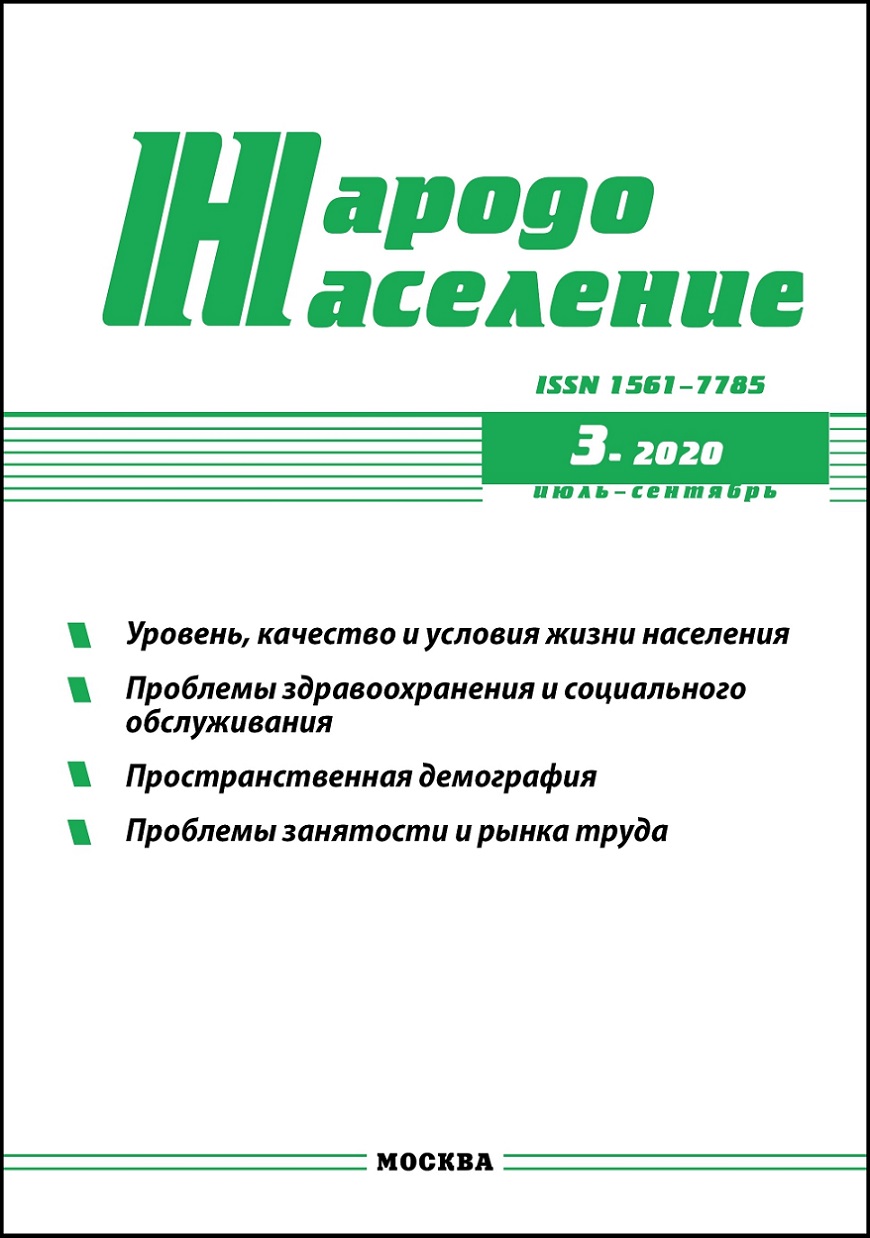Население и регионы в Стратегии пространственного развития страны
Научная статья
Выражение признательности
Исследование выполнено в рамках НИР по Государственному заданию «Анализ деятельности населения регионов России в сферах финансового поведения, распространения информационных технологий, естественного и миграционного движения» № 0165-2018-0005
Для цитирования
Пациорковский В. В. Население и регионы в Стратегии пространственного развития страны // Народонаселение. 2020. Том 23. № 3. С. 96-108. DOI: https://doi.org/10.19181/population.2020.23.3.9
Аннотация
В статье анализируется методология и содержание Стратегии пространственного развития Российской Федерации до 2025 года (далее — Стратегия). Особое внимание уделено поставленной в Стратегии задаче совершенствования системы расселения населения и отражения в ней региональной проблематики. Ориентация Стратегии на крупные города находится в противоречии с задачами национального проекта «Демография». Стягивая население в крупные города, трудно достичь целевого показателя «Увеличение суммарного коэффициента рождаемости до 1,7 на одну женщину до 2024 г.». Для стратегии пространственного развития, задачей которой провозглашено совершенствование системы расселения населения проблематика его воспроизводства и размещения далеко не праздный вопрос. И тем не менее в Стратегии этот вопрос не выходит за рамки дежурных обобщений, в которых провозглашается дифференцированный подход к направлениям и мерам государственной поддержки социально-экономического развития территорий с учетом демографической ситуации, особенностей системы расселения, уровня и динамики развития экономики и специфических природных условий. А сформулированный в Стратегии тезис: «Стабилизация численности населения в большинстве субъектов Российской Федерации», фактически не имеет под собой оснований. В 2005-2018 гг. две трети регионов (67,1%) теряли численность населения. Анализ места и роли в Стратегии взятого для примера региона (Республика Коми) показывает, что, в сравнении с большинством других субъектов федерации, этой республике уделено довольно много внимания и места. Она описана в составе Северного макрорегиона, дана экономическая специализация республики, ее столица город Сыктывкар представлен в числе перспективных экономических центров, ряд муниципальных образований республики выделены в составе минерально-сырьевых центров, а город Воркута включен в состав приоритетных геостратегических территорий Арктической зоны. И это вполне понятно. Пространственное развитие страны ориентировано в первую очередь на Север и Восток.
Ключевые слова:
Стратегия пространственного развития, города, муниципальные образования, перспективные центры экономического роста, геостратегические территории, население
Литература
1. Бухвальд Е.М. Стратегия пространственного развития Российской Федерации и новации в государственной региональной политике. // Россия: тенденции и перспективы развития. Ежегодник. Выпуск 14. Часть 1. — М.: ИНИОН РАН, 2019. — 937 с. — С. 48-52.
2. Смирнова О. О. Основы стратегического планирования Российской Федерации. — М.: Наука, 2013. — 302 с.
3. Петров М.Б. Пространственная парадигма как основа управления развитием транспортной системы. // Россия: тенденции и перспективы развития. Ежегодник. Выпуск 14. Часть 1. — М.: ИНИОН РАН, 2019. — 937 с. — С. 187-189.
4. Национальные проекты: целевые показатели и основные результаты. [Электронный ресурс] — Режим доступа: http://static.government.ru/media/files/p7nn2CS0pVhvQ98OOwAt2dz CIAietQih.pdf (дата обращения: 14.04.2020).
5. Послание Президента Федеральному Собранию 15 января 2020 г. [Электронный ресурс] — Режим доступа: http://kremlin.ru/events/president/news/62582 (дата обращения: 16.04.2020).
6. Лаженцев В.Н. Содержание, системная организация и планирование территориального развития. — Екатеринбург-Сыктывкар: ИСЭЭПС УО РАН, 2014. — 236 с.
7. Коми. Фонд «Серебряная тайга» реализует проект «Лесная деревня». [Электронный ресурс] — Режим доступа: http://www.wood.ru/ru/lonewsid-34171.html (дата обращения: 21.04.2020).
8. Пациорковский В.В. Обеспечение безопасности продовольствия. // Продовольственный рынок регионов России в системе глобальных рисков. / Под общей редакцией академика РАН А. И. Татаркина. — Екатеринбург: Институт экономики УрО РАН, 2012. — с. 45-55.
9. Пациорковский В.В. Семейные хозяйства — страховое звено продовольственной безопас¬ности, здорового питания и благополучия людей. // Будущее продовольственной системы России (в оценках экспертного сообщества). / Ред. В. Ф. Лищенко. — М.: Экономика, 2014. — С. 130-153.
10. Чернов В. Воркута, Ухта, Печора стали лидерами по сокращению численности населения. // Комсомольская правда. Электронная версия. 31.03.2017. [Электронный ресурс] — Режим доступа: https://www.komi.kp.ru/daily/26660/3681715/ (дата обращения: 19.04.2020).
11. История Пустозерска. // Пустозерск. [Электронный ресурс] — Режим доступа: http://pustozersk-nao.ru/index.php/ru/novosti/19-den-pustozerska (дата обращения: 22.02.2020).
2. Смирнова О. О. Основы стратегического планирования Российской Федерации. — М.: Наука, 2013. — 302 с.
3. Петров М.Б. Пространственная парадигма как основа управления развитием транспортной системы. // Россия: тенденции и перспективы развития. Ежегодник. Выпуск 14. Часть 1. — М.: ИНИОН РАН, 2019. — 937 с. — С. 187-189.
4. Национальные проекты: целевые показатели и основные результаты. [Электронный ресурс] — Режим доступа: http://static.government.ru/media/files/p7nn2CS0pVhvQ98OOwAt2dz CIAietQih.pdf (дата обращения: 14.04.2020).
5. Послание Президента Федеральному Собранию 15 января 2020 г. [Электронный ресурс] — Режим доступа: http://kremlin.ru/events/president/news/62582 (дата обращения: 16.04.2020).
6. Лаженцев В.Н. Содержание, системная организация и планирование территориального развития. — Екатеринбург-Сыктывкар: ИСЭЭПС УО РАН, 2014. — 236 с.
7. Коми. Фонд «Серебряная тайга» реализует проект «Лесная деревня». [Электронный ресурс] — Режим доступа: http://www.wood.ru/ru/lonewsid-34171.html (дата обращения: 21.04.2020).
8. Пациорковский В.В. Обеспечение безопасности продовольствия. // Продовольственный рынок регионов России в системе глобальных рисков. / Под общей редакцией академика РАН А. И. Татаркина. — Екатеринбург: Институт экономики УрО РАН, 2012. — с. 45-55.
9. Пациорковский В.В. Семейные хозяйства — страховое звено продовольственной безопас¬ности, здорового питания и благополучия людей. // Будущее продовольственной системы России (в оценках экспертного сообщества). / Ред. В. Ф. Лищенко. — М.: Экономика, 2014. — С. 130-153.
10. Чернов В. Воркута, Ухта, Печора стали лидерами по сокращению численности населения. // Комсомольская правда. Электронная версия. 31.03.2017. [Электронный ресурс] — Режим доступа: https://www.komi.kp.ru/daily/26660/3681715/ (дата обращения: 19.04.2020).
11. История Пустозерска. // Пустозерск. [Электронный ресурс] — Режим доступа: http://pustozersk-nao.ru/index.php/ru/novosti/19-den-pustozerska (дата обращения: 22.02.2020).
Статья
Поступила: 20.05.2020
Опубликована: 25.09.2020
Форматы цитирования
Другие форматы цитирования:
APA
Пациорковский, В. В. (2020). Население и регионы в Стратегии пространственного развития страны. Народонаселение, 23(3), 96-108. https://doi.org/10.19181/population.2020.23.3.9
Раздел
ПРОСТРАНСТВЕННАЯ ДЕМОГРАФИЯ








